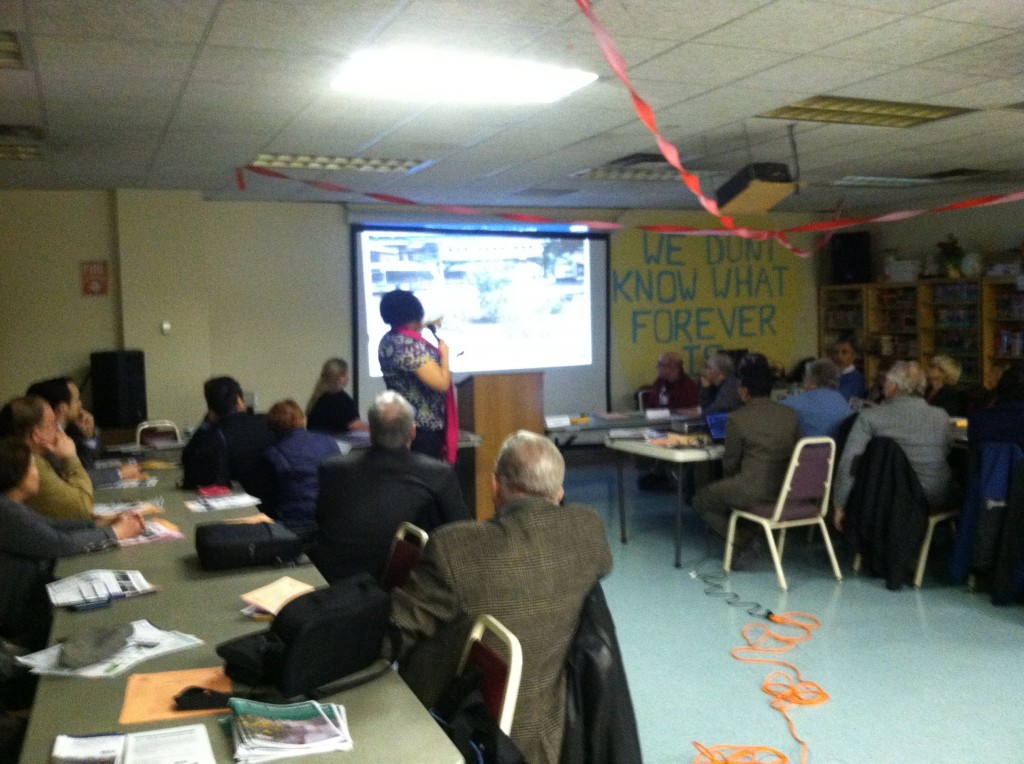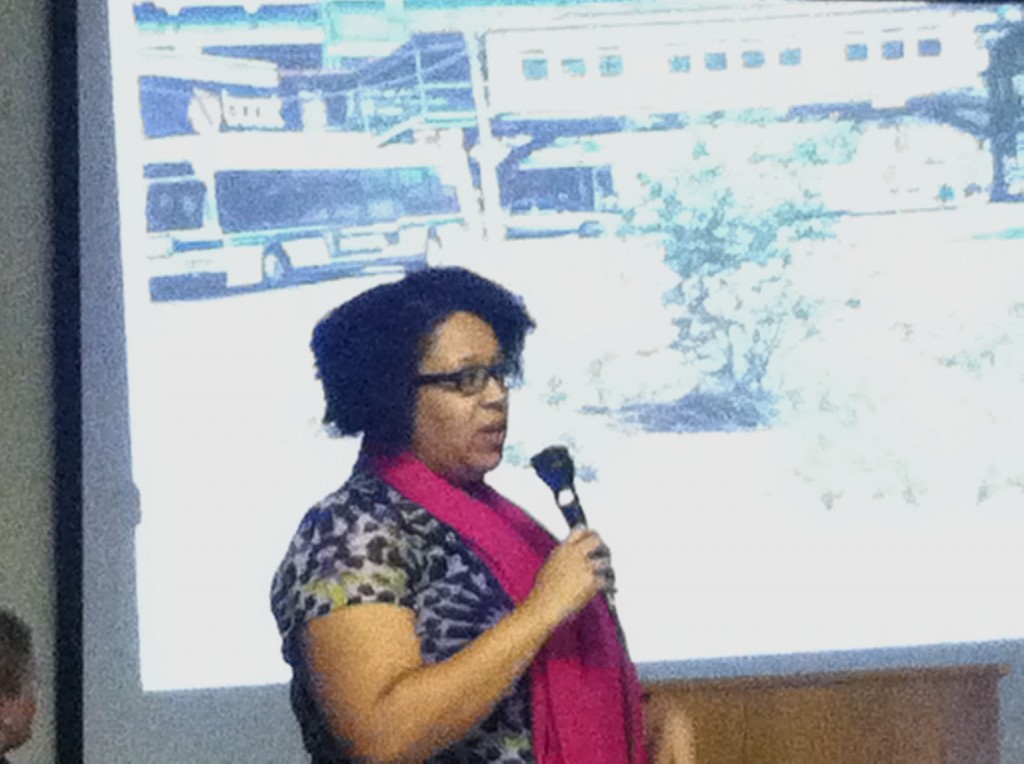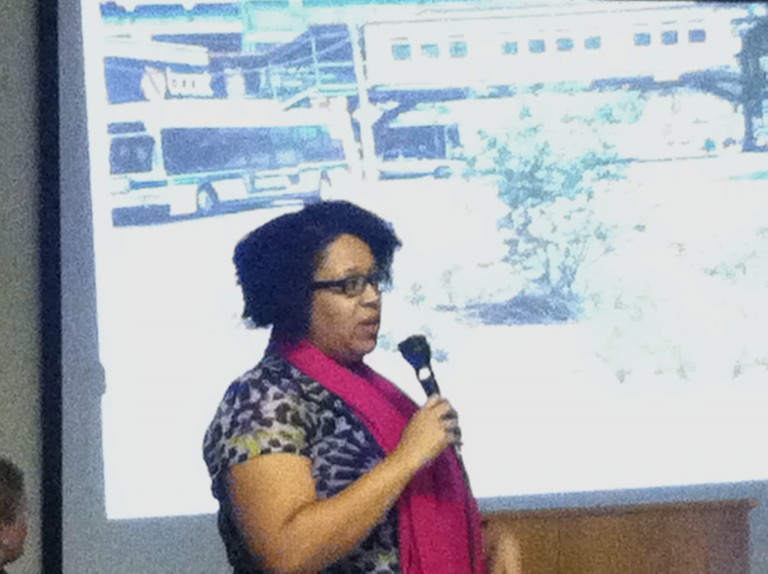
Residents at the Community Board 6 meeting said they were concerned about the impact of bioswales in the Forest Hills and Rego Park area. Kerry Goleski/The Forum Newsgroup
Community Board 6, which encompasses Forest Hills and Rego Park, is a high yield area for combined sewer runoff into Flushing Bay. The city Department of Environmental Protection is installing green infrastructure in areas where combined sewer water runoff affects the water quality in local waterways.
Mikelle Adgate, project manager at the city DEP, presented information about green infrastructure in the CB6 area during the board’s last meeting on Nov. 13.
“In terms of Community Board 6, every time it rains in this community board, the rain mixes with sanitary flow from our homes and buildings,” Adgate told board members and residents at the meeting.

Mikelle Adgate, a project manager at the city Department of Environmental Protection, presented information about bioswales at last week’s Community Board 6 meeting.
That mixture is known as combined sewer runoff, which Adgate said, “discharges into Flushing Bay.”
They are looking to improve water quality by installing different types of green infrastructure, including right-of-way (ROW) bioswales and stormwater greenstreets. The infrastructure is put in place to be able to collect rainwater without it flowing into the streets where it can combine with sanitary run-off and pollute the water as combined sewer overflow, CSO.
A ROW bioswale is a planted area constructed on the sidewalk between the roadway and the private property line that collects rainwater to prevent the rainwater from going into the combine sewer system.
Stormwater greenstreets similarly collect rainwater to prevent CSO but are usually constructed in the roadway and are larger than ROW bioswales. They both look like planted areas with a deeper soil and a more complex drainage system so they can hold more water than a regular planted area.
Forest Hills and Rego Park residents are experiencing the beginning phase of the installation. A small number of infrastructure projects are installed and being maintained already while they are starting to map out other potential locations.
Despite the potential positive environmental effects, there are concerns from the public about the construction, installation and existence of these structures in the local community.
CB 6 Chairman Joseph Hennessy voiced concern about who is designated to maintain the bioswale but Adgate said there will be Parks Department workers that specialize in bioswale maintenance and each bioswale will be checked on at least once a week.
Other residents echoed the concern about the maintenance and also mentioned that they were worried about the potential of the structures becoming a parking hazard.
Two Forest Hills families attended the meeting to voice their concern about the potential bioswales in front of their property. Mary Bartlotto lives on 75th Avenue and said the DEP chose a location in front of her house as a potential spot for a bioswale. In the process of choosing where the bioswale can go, they took a soil sample.
“They showed up to our property one morning and they let behind an indent on my lawn,” she said. “They should give the homeowner a fair warning.”
She raised another concern about mosquitos.
“I know in Oregon they have these but they are infested with mosquitos.”
DEP’s Shane Ojar said that they will drain before 72 hours and that it takes mosquitos that long to begin to breed. He said, “The water drains from 12-24 hours. We will make sure you can live symbiotically with the bioswales.”
The Allen family, who live across the street from Bartlotto, raised concerns about the safety, the parking and practically of choosing the location in front of their home.
“We respectfully suggest a location other than in front of our home,” said Forest Hills resident William Allen.
They are concerned that the sidewalk space is not the standard five feet necessary for a bioswale, that people will cause safety issues, and that they will have to take away two parking spots.
As of now, DEP has identified potential spaces for the green infrastructure but that does not mean there will definitely be a bioswale constructed in that location. It is being considered based on soil sampling and surveying.
Adgate said, “We will know when locations will be final, next spring. We will send updated maps to the community board. We will notify nearby property owners 30 days ahead of time.”
Hennessy said the board will advise the DEP to take both families off of the potential bioswale list.
By Kerry Goleski

